The Reverse Switch Gearbox is a critical component ensuring your vehicle’s reverse lights function correctly, enhancing safety when maneuvering backward. Malfunctioning reverse lights can be a significant safety hazard, making it crucial to understand the reverse switch and how to troubleshoot potential issues. This guide will delve into the common problems associated with the reverse switch gearbox and provide practical solutions for diagnosing and fixing them.
Understanding the Reverse Switch Gearbox
The reverse switch gearbox, often simply called the reverse switch, is a small electrical switch typically located on the transmission. Its primary function is to activate the reverse lights when the gear selector is placed in the reverse position. The switch is designed to complete an electrical circuit when the gearbox is in reverse, sending power to the reverse lights. When the gearbox is shifted out of reverse, the circuit is broken, turning off the lights. Different car models may have varying placements and types of reverse switches.
Common Problems and Solutions
Several issues can cause reverse lights to malfunction. Here are some of the most common problems associated with the reverse switch gearbox and how to address them:
1. Faulty Reverse Switch: The most common culprit is a malfunctioning reverse switch. Over time, the switch can wear out, become corroded, or suffer internal damage.
- Solution: Testing the switch is the first step. This can often be done by disconnecting the electrical connector and using a multimeter to check for continuity between the terminals when the switch plunger is depressed. If there’s no continuity, the switch needs replacement. Reverse switches are relatively inexpensive and easy to replace.
2. Wiring Issues: Damaged or corroded wiring connecting the reverse switch to the lights can also prevent the lights from working.
- Solution: Carefully inspect the wiring harness for any visible damage, breaks, or corrosion. A multimeter can be used to test the continuity of the wires. Repair or replace any damaged sections as needed.
3. Blown Fuse: A blown fuse in the circuit powering the reverse lights will obviously prevent them from operating.
- Solution: Locate the fuse box in your vehicle (usually under the dashboard or in the engine compartment) and consult the owner’s manual to identify the correct fuse for the reverse lights. Replace the blown fuse with a new one of the same amperage.
4. Incorrect Adjustment: On some vehicles, the reverse switch may require adjustment to engage properly when the gearbox is in reverse.
- Solution: Consult your vehicle’s repair manual for specific instructions on adjusting the reverse switch. This usually involves loosening a locknut and turning the switch body to adjust its position.
5. Gearbox Problems: In rare cases, internal issues within the gearbox itself can prevent the reverse switch from being activated correctly.
- Solution: This is a more complex problem that likely requires professional diagnosis and repair. Symptoms might include difficulty engaging reverse gear or unusual noises from the transmission.
Preventive Maintenance
Regular maintenance can help prevent issues with your reverse switch gearbox:
- Inspection: Periodically inspect the reverse switch and its wiring for signs of damage or corrosion.
- Cleaning: Clean the switch and its electrical connector with a suitable electrical contact cleaner.
- Lubrication: On some models, the switch mechanism may benefit from lubrication with a dielectric grease.
Conclusion
A functioning reverse switch gearbox is crucial for safe vehicle operation. By understanding the common problems and solutions outlined in this guide, you can effectively troubleshoot and resolve issues with your reverse lights, ensuring safer reversing maneuvers. If you are uncomfortable performing these tasks yourself, consult a qualified mechanic for assistance.


